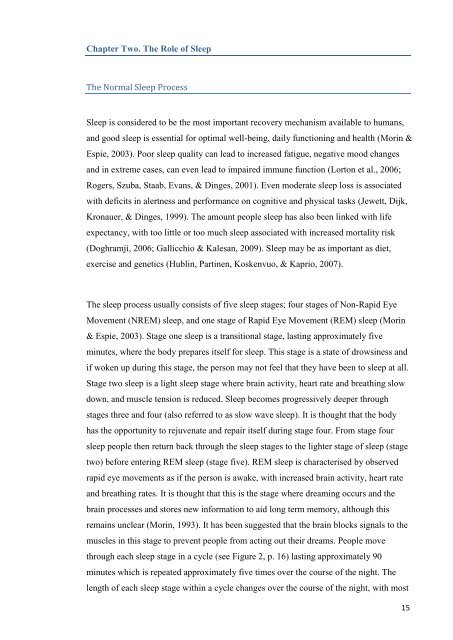Sick and Tired: Understanding and Managing Sleep Difficulties in ...
Sick and Tired: Understanding and Managing Sleep Difficulties in ...
Sick and Tired: Understanding and Managing Sleep Difficulties in ...
Create successful ePaper yourself
Turn your PDF publications into a flip-book with our unique Google optimized e-Paper software.
Chapter Two. The Role of <strong>Sleep</strong><br />
The Normal <strong>Sleep</strong> Process<br />
<strong>Sleep</strong> is considered to be the most important recovery mechanism available to humans,<br />
<strong>and</strong> good sleep is essential for optimal well-be<strong>in</strong>g, daily function<strong>in</strong>g <strong>and</strong> health (Mor<strong>in</strong> &<br />
Espie, 2003). Poor sleep quality can lead to <strong>in</strong>creased fatigue, negative mood changes<br />
<strong>and</strong> <strong>in</strong> extreme cases, can even lead to impaired immune function (Lorton et al., 2006;<br />
Rogers, Szuba, Staab, Evans, & D<strong>in</strong>ges, 2001). Even moderate sleep loss is associated<br />
with deficits <strong>in</strong> alertness <strong>and</strong> performance on cognitive <strong>and</strong> physical tasks (Jewett, Dijk,<br />
Kronauer, & D<strong>in</strong>ges, 1999). The amount people sleep has also been l<strong>in</strong>ked with life<br />
expectancy, with too little or too much sleep associated with <strong>in</strong>creased mortality risk<br />
(Doghramji, 2006; Gallicchio & Kalesan, 2009). <strong>Sleep</strong> may be as important as diet,<br />
exercise <strong>and</strong> genetics (Hubl<strong>in</strong>, Part<strong>in</strong>en, Koskenvuo, & Kaprio, 2007).<br />
The sleep process usually consists of five sleep stages; four stages of Non-Rapid Eye<br />
Movement (NREM) sleep, <strong>and</strong> one stage of Rapid Eye Movement (REM) sleep (Mor<strong>in</strong><br />
& Espie, 2003). Stage one sleep is a transitional stage, last<strong>in</strong>g approximately five<br />
m<strong>in</strong>utes, where the body prepares itself for sleep. This stage is a state of drows<strong>in</strong>ess <strong>and</strong><br />
if woken up dur<strong>in</strong>g this stage, the person may not feel that they have been to sleep at all.<br />
Stage two sleep is a light sleep stage where bra<strong>in</strong> activity, heart rate <strong>and</strong> breath<strong>in</strong>g slow<br />
down, <strong>and</strong> muscle tension is reduced. <strong>Sleep</strong> becomes progressively deeper through<br />
stages three <strong>and</strong> four (also referred to as slow wave sleep). It is thought that the body<br />
has the opportunity to rejuvenate <strong>and</strong> repair itself dur<strong>in</strong>g stage four. From stage four<br />
sleep people then return back through the sleep stages to the lighter stage of sleep (stage<br />
two) before enter<strong>in</strong>g REM sleep (stage five). REM sleep is characterised by observed<br />
rapid eye movements as if the person is awake, with <strong>in</strong>creased bra<strong>in</strong> activity, heart rate<br />
<strong>and</strong> breath<strong>in</strong>g rates. It is thought that this is the stage where dream<strong>in</strong>g occurs <strong>and</strong> the<br />
bra<strong>in</strong> processes <strong>and</strong> stores new <strong>in</strong>formation to aid long term memory, although this<br />
rema<strong>in</strong>s unclear (Mor<strong>in</strong>, 1993). It has been suggested that the bra<strong>in</strong> blocks signals to the<br />
muscles <strong>in</strong> this stage to prevent people from act<strong>in</strong>g out their dreams. People move<br />
through each sleep stage <strong>in</strong> a cycle (see Figure 2, p. 16) last<strong>in</strong>g approximately 90<br />
m<strong>in</strong>utes which is repeated approximately five times over the course of the night. The<br />
length of each sleep stage with<strong>in</strong> a cycle changes over the course of the night, with most<br />
15

















